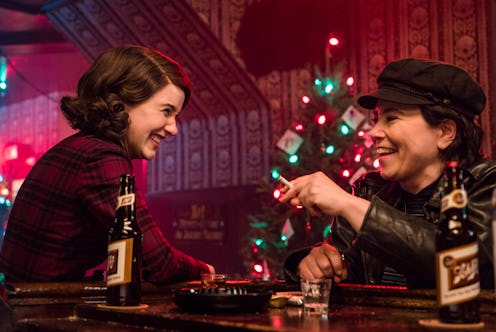Entertainment
These Are 14 Of The Best Pop Culture References in 'The Marvelous Mrs. Maisel'

The Marvelous Mrs. Maisel is a lot of things: a tribute to a certain era in New York City, critique of the comedy scene for women, and empowering manifesto for feminism. But one thing some forget is just how many pop culture references creator Amy Sherman-Palladino can pack into an hour of television. (Or into one overly-caffeinated conversation between Lorelei and Rory Gilmore.) While one is busy following Midge's evolution from Upper West Side housewife to downtown comedienne some of the best pop culture references in The Marvelous Mrs. Maisel are in plain sight.
Whether the presence of a historical comedian or blink-and-you-missed-it reference to a celebrity, the show's tone is only enhanced by its homages to other iconic institutions. In the words of the all-knowing Susie Myerson, "I don't mind being alone. I just do not want to be insignificant." These are the most significant references to people, places, and pop culture onstage and off.
As fans anticipate Season 3 of the hit Amazon comedy, it's the perfect time to reflect on the first two seasons of the show, and the smaller, poppy moments within them. Some iconic songs, comedy acts, and restaurants, all centered in New York found their way into The Marvelous Mrs. Maisel— here's 14 of the best.
1Barbra Streisand
One of the subtle through lines on Maisel is references to Barbra Streisand. It makes sense that homage would be paid to an iconic Jewish female performer on a show centered around one. Barbra's versions of "Happy Days Are Here Again" and "Just Leave Everything to Me" can be heard at two major series moments. And when Midge is deciding on an effective stage name, Streisand's Funny Girl character Fanny Brice is an option.
2Yoko Ono "Cameo"
In Season 2 Episode 7, a familiar face is shown for just a few seconds, but the reference is hilarious. A person who looks to be Yoko Ono is shown viewing a painting in the same gallery as Midge and Benjamin. A mix of real figures in this fictional world is always fun to notice.
3Gilmore Girls, Obviously
Sherman-Palladino loves throwing out a bone to all of her Gilmore Girls faithfuls. And big or small, whenever she does, we are here for it. Season 2's trip to the Catskills gave some major Stars Hollow vibes with its town hall meetings and frequent kitschy events. Fans have even noticed that Stage Door Deli, Susie and Midge's hangout, is reminiscent of Luke's.
4Bob Newhart's Comedy Act
One of the pivotal turning points in the series' pilot is when Midge realizes her husband Joel's genius comedy act is lifted from none other than Bob Newhart. It is a great historical callback and indicator that Joel may not be 'Husband of the Year.'
5Lenny Bruce
One of the series' main characters is Lenny Bruce, based on a real comic, who acts as inspiration for Midge's own career in comedy. Many of his jokes, including his act about being all alone that closes out Season 2, are from the real-life comedian.
6Liberace Playing the Typewriter
In Season 1, Episode 4, while Midge moves her belongings from the apartment she shared with her husband, her son Ethan sits by the TV watching Liberace play a typewriter. It was a famous television appearance at the time.
7Jane Jacobs' Rally
Maisel loves to reference real historical events, including activist Jane Jacobs' rally at Washington Square Park. Her, and an army of other women, protesting is another spark in an overarching catalyst for Midge speaking her mind.
8Sylvia Plath
One of the best under-the-radar references comes in the Season 2 premiere. After Midge finishes performing an impromptu set at a Parisian night club, a woman gives her the number of a psychoanalyst telling Midge, "He's done wonders for my friend Sylvia Plath."
9Late Night TV
Late night television not only provided a springboard for up-and-coming comics who could secure a slot, but inspiration for new material. Several late night hosts of the 50s are referenced including Jack Parr, Midge's personal favorite.
10Elizabeth Taylor
Elizabeth Taylor is also referenced several times throughout the show. Her love affairs, and frequent divorces are joked about in multiple episodes, indicating the front-page focused nature of her life in the spotlight.
11Shy Baldwin
Shy Baldwin, the singer Midge meets before her star-making telethon set, is not a real musician. But many have speculated that he's a reference to Harry Belafonte. Baldwin is sure to play a major role in Season 3, after inviting Midge to open for his world tour.
12Broadway
Two significant Broadway shows and their reputations on the Great White Way are referenced. First, Joel's friends ditch a double date with him and his secretary-turned-girlfriend Penny at The Music Man. This slight is even more pronounced given how popular the show was at the time. In Season 2, Midge and Benjamin go to a new show, The Legend of Lizzie, leaving at intermission. It turns out they weren't the only ones given the show was a notorious flop.
13Iconic Locations
Several legendary locales from the New York comedy scene are shown including The Friars Club with Ed Sullivan that Susie has to sneak into, and the City Spoon eatery. Not to mention that the Gaslight was a real spot back in the day.
14Redd Foxx Comedy Album
One of the comedy albums Susie tasks Midge with listening to in order to hone her craft is by comedian Redd Foxx, who was known for his provocative comedy in the '50s and '60s before he starred on the sitcom Sanford and Son. His comedy helps Midge realize a new way of exploring stand-up.
As the series inches closer to the '60s for Season 3, there are sure to be even more pop culture references in the show's future.